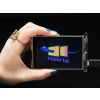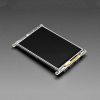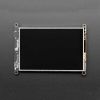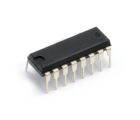Adafruit PyPortal Titano
Available with a lead time
Expect dispatch between Jan 05 and Jan 09
Quantity Discounts:
- 10+ $92.55 (exc GST)
- 50+ $90.64 (exc GST)
The PyPortal Titano is the big sister to Adafruit's popular PyPortal now with twice as many pixels! The PyPortal is Adafruit's easy-to-use IoT device that allows you to create all the things for the “Internet of Things” in minutes. Make custom touch screen interface GUIs, all open-source, and Python-powered using tinyJSON / APIs to get news, stock, weather, cat photos, and more – all over Wi-Fi with the latest technologies. Create little pocket universes of joy that connect to something good. Rotate it 90 degrees, it’s a web-connected conference badge #badgelife.
The Titano uses an ATMEL (Microchip) ATSAMD51J20, and an Espressif ESP32 Wi-Fi coprocessor with TLS/SSL support built-in. PyPortal has a bigger 3.5″ diagonal 320 x 480 color TFT with resistive touch screen. Compare that to the original PyPortal's 3.2" 240x320, Adafruit have twice as many pixels! Also, Adafruit have updated the connector to be a reverse-friendly USB C connector.
Compared to the original PyPortal, the Titano does not include a ADT7410 temperature sensor. It also has a higher-resolution screen with a different controller chip. The Processor, STEMMA conectors and WiFi have the exact same wiring as the original 3.2" PyPortal so if you are running Arduino/CircuitPython code, you'll just have to adjust your graphics and fonts for the larger resolution screen!
The PyPortal Titano includes: speaker, light sensor, temperature sensor, NeoPixel, microSD card slot, 8MB flash, plug-in ports for I2C and 2 analog/digital pins. Open-source hardware, and Open-Source software, CircuitPython and Arduino. The device shows up as a USB drive and the code (Python) can be edited in any IDE, text editor, etc.
The M4 and ESP32 are a great couple - and each bring their own strengths to this board. The SAMD51 M4 has native USB so it can show up like a disk drive, act as a MIDI or HID keyboard/mouse, and of course bootload and debug over a serial port. It also has DACs, ADC, PWM, and tons of GPIO. Meanwhile, the ESP32 has secure WiFi capabilities, and plenty of Flash and RAM to buffer sockets. By letting the ESP32 focus on the complex TLS/SSL computation and socket buffering, it frees up the SAMD51 to act as the user interface. You get a great programming experience thanks to the native USB with files available for drag-n-drop, and you don't have to spend a ton of processor time and memory to do SSL encryption/decryption and certificate management. It's the best of both worlds!
Exact shipping can be calculated on the view cart page (no login required).
Products that weigh more than 0.5 KG may cost more than what's shown (for example, test equipment, machines, >500mL liquids, etc).
We deliver Australia-wide with these options (depends on the final destination - you can get a quote on the view cart page):
- $3+ for Stamped Mail (typically 10+ business days, not tracked, only available on selected small items)
- $7+ for Standard Post (typically 6+ business days, tracked)
- $11+ for Express Post (typically 2+ business days, tracked)
- Pickup - Free! Only available to customers who live in the Newcastle region (must order online and only pickup after we email to notify you the order is ready). Orders placed after 2PM may not be ready until the following business day.
Non-metro addresses in WA, NT, SA & TAS can take 2+ days in addition to the above information.
Some batteries (such as LiPo) can't be shipped by Air. During checkout, Express Post and International Methods will not be an option if you have that type of battery in your shopping cart.
International Orders - the following rates are for New Zealand and will vary for other countries:
- $12+ for Pack and Track (3+ days, tracked)
- $16+ for Express International (2-5 days, tracked)
If you order lots of gear, the postage amount will increase based on the weight of your order.
Our physical address (here's a PDF which includes other key business details):
40 Aruma Place
Cardiff
NSW, 2285
Australia
Take a look at our customer service page if you have other questions such as "do we do purchase orders" (yes!) or "are prices GST inclusive" (yes they are!). We're here to help - get in touch with us to talk shop.
Have a product question? We're here to help!
Videos
View AllGuides
How to Set Up a Raspberry Pi Kiosk - Launch a Fullscreen Webpage on Boot!
Using USB and Bluetooth Controllers with Python
How to Build a RetroPie Console
Gaming Kit for RetroPie
Projects
Using USB and Bluetooth Controllers with Python
How to Build a RetroPie Console
Gaming Kit for RetroPie
Makers love reviews as much as you do, please follow this link to review the products you have purchased.
















Product Comments